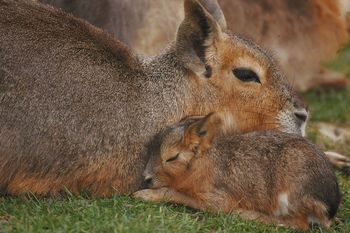Capybara Facts
Capybara Facts
|
| Interesting Capybara Facts: |
|---|
| Fully grown capybara reaches 4 feet in length and weight of 140 pounds. Females are larger than males. |
| They have barrel-shaped body covered with brown wiry fur. |
| They are herbivores (eat plants). They graze grass and eat aquatic plants most of the night. They also eat fruit and bark of the tree. |
| Adult animal eats 8 pounds of grass per day. |
| Although they are not related to ruminants, capybaras regurgitate their food and chew it several times. |
| They also eat their own feces to provide bacteria that help in digestion of food. |
| Jaguars, anacondas, caimans, harpy eagles hunt and eat capybaras. |
| When they sense danger, they produce warning bark which alerts other members of the group. Besides barking, they can purr, whistle, squeal and grunt. |
| Scents are another way of communication. Males release substance produced in special glands to mark their territory. Females release smelly substances only when they need to inform males that they are ready for mating. |
| They live in large group, from 10-30 members. During dry season, group can have more than 100 members. |
| Most dominant male is the leader of the group. He is in charge for their safety. Capybaras are excellent swimmers and divers. They can keep their breath 5 minutes under water in the case of danger. |
| Capybaras usually have one litter per year. Pregnancy lasts 5-6 months and ends with 4 babies. |
| All females in the group take care of all young capybaras because they are easy target for jaguars. |
| Even though babies eat mother's milk 16 weeks, they will start to graze few days after they are born. |
| Capybaras live 8-10 years in the wild and up to 12 years in captivity. |
|
Related Links: Facts Animal Facts Animals Facts |

 Although they look like beavers, capybaras are large rodents. They live in Central and South America. Capybaras like water and they can be found in swampy areas, near lakes, ponds, rivers…Number of capybaras dropped drastically few years ago due to uncontrolled hunt. Today, thanks to farming of capybaras, their number in the wild recovered.
Although they look like beavers, capybaras are large rodents. They live in Central and South America. Capybaras like water and they can be found in swampy areas, near lakes, ponds, rivers…Number of capybaras dropped drastically few years ago due to uncontrolled hunt. Today, thanks to farming of capybaras, their number in the wild recovered.